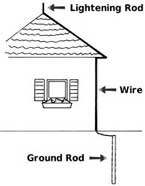Want To Install A Lightning Rod? This Is How
 Concerns about the lightning strike when the rainy season could become commonplace. Lightning that conduct electricity thousands of volts can also make electronic equipment on fire. How to keep the house not struck by lightning? It’s simple. You just have to install a lightning rod in the area around the house.
Concerns about the lightning strike when the rainy season could become commonplace. Lightning that conduct electricity thousands of volts can also make electronic equipment on fire. How to keep the house not struck by lightning? It’s simple. You just have to install a lightning rod in the area around the house.
Installing a lightning rod is not difficult, it’s only consists of the head of lightning rod, the wire that connects the head to the ground, and the ground rod. Put a lightning rod in the highest building, can also be mounted on a metal pole that rose around the building. There are a few things you need to consider when it comes to installing a lightning rod.
- Make sure the component system of lightning rod is securely installed and perfect. Installation which is not perfect cause lightning rod system is not working effectively and damaged when struck by lightning.
- Planting ground rod to a depth of ground water or until it reaches the wet area. The goal for electrical lightning channeled directly into the ground.
- Place the instrument lightning at the highest part of the house. If using a regular, pairs with a maximum distance 3m between lightning rod. Make sure the size of lightning rod right. For houses, sizes of 30cm or 27cm are enough. The larger the diameter of the head lightning rod and wire, the better the system works.
- Consider the installation of network devices, ranging from the head unit of lightning rod, wire to the grounding system. If not, the lightning rod will break down, bend or break if struck by lightning.
- There are many options of lightning rod with various models and materials. Select the most effective electrical leads thousands of volts.
lightning rod, lightning strike, pairs, rainy season, volts







